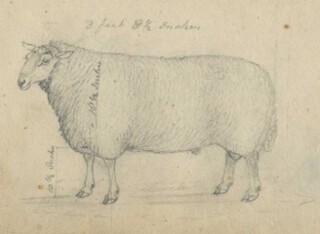Thomas Bewick’s Sketchbook
Esther Chadwick
A perfect farm animal, according to the 18th-century agronomist Robert Bakewell, would be shaped like a hogshead cask, ‘truly circular, with as small and as short legs as possible’. Bakewell’s ideal was founded ‘upon the plain principle that the value lies in the barrel’. There was no need for long limbs or lean necks: ‘all is useless that is not beef.’ This applied not only to cattle,but to pigs and sheep too, which after 1750 came to be reared as ‘production line animals’.
The key was not just intensive cross or ‘in-and-in’ breeding (otherwise known as incest), but newly developed protein-rich foods, such as linseed oil cake, to supplement a diet of turnips and cabbage. Animals that had taken six years to mature were now ready for slaughter in two. Prize animals with monstrous rumps and disappearing necks – ‘fatstock’ – were paraded at auctions and shows,and celebrated in paintings and prints commissioned by their owners. While Enclosure was transforming the English landscape, stockbreeding was changing the appearance of the animals that grazed in it.
A corpulent ram with a coy eye in his tiny head peers patiently out from a page in the rediscovered sketchbook of Thomas Bewick (1753-1828), now published by Jarndyce in a facsimile edition. Bewick – best known for his illustrated natural histories, Quadrupeds (1790) and British Birds (1797 and 1804) – has taken care to annotate the ram’s vital statistics: 10½ inches of leg, 18½ inches from shoulder to foreshank, 3 feet 8½ inches along the woolly barrel of the body from neck to tail.
The next page contains draft lettering for an engraved broadside, A Comparative View of Two Cheviot Rams, dedicated to the honorary members of the Society for the Improvement of Cheviot Sheep. In the printed broadside, the prized ram is compared with a scrawnier creature with spindlier legs, and both are placed along ruled lines of scale, in order to show the changes made to Cheviots by the stockbreeder Thomas Smith. Another page in the sketchbook is given over to a preparatory drawing for Smith’s ‘stud card’, in which the engraved image of Whitham, the ram, served as a kind of business card.
Bewick was not the kind of artist to flatter the flocks of yeomen or the smarter farmers he called ‘Agricultural Gentlemen’: ‘I would not put lumps of fat here & there to please them where I could not see it,’ he said. Honesty of observation was his guiding principle. ‘Truth is to bend to nothing, but all to her.’
Other improved breeds featured in the sketchbook include the ‘Tees-Water Improved Breed’ of sheep, the ‘Improved Holstein’ cow and an improved Heath Ram belonging to the Bishop of Durham. A stranger among the domestic animals is a wily hyena; Bewick must have seen it on show in Gilbert Pidcock’s travelling menagerie in 1799.
Beneath his sketch of ‘The Sow of the Improved Breed’, Bewick has totted up some numbers – 18 plus 12 plus 19 equals 49 – and added the words ‘in 10 months’. The 1800 edition of the Quadrupeds, where the sow and her pendulous burden of teats appeared in published form, makes sense of these jottings. ‘She had a litter of nineteen pigs to support at the time, which was the third within ten months: the whole amounted in that time, to nearly fifty pigs’ – the sow as a reproducing machine. Everywhere in the sketchbook, Bewick is adding things up, taking account, measuring. As in the schematic aerial views of a new canal that occupy two pages, he is mapping the changing world around him objectively and modestly, with little flourish.
The sketchbook is also an account book for Bewick’s own body. As he journeyed to and from his farming clients, he used it to record expenditure on food, shelter and transport – five shillings for tea at the City Tavern in Durham in May 1796; ‘supp’d & slept’ for 14 shillings at the Castle Eden Inn that night; three shillings to tip the factory workers at a cotton mill near Hartlepool the next day; threepence for a shave, 1s 3d for a new handkerchief. 15s 7d for tea, supper and bed in Sunderland. Sixpence for a boot-man, 5d for a chambermaid.
Bewick preferred to travel on his own two feet, but other modes of transport are recorded in these diligent lists: the cost of provisions (‘Sea Stock’) for the short voyage from Hartlepool to Sunderland; £1 7s for a diligence (a public stagecoach) from Newcastle to Hexham in June 1792; £1 10s 8d to hire a Galloway nag in 1798 for the 40-mile ride to Thomas Smith’s and back. Then there was the Royal Telegraph that Bewick caught at 6 a.m. from the Shakespeare Tavern, Newcastle on 2 July 1798: a ‘new and elegant Light Coach, with four Horses and Careful Drivers’ that could get you to London in 47 hours – a coach of the improved breed.

Comments